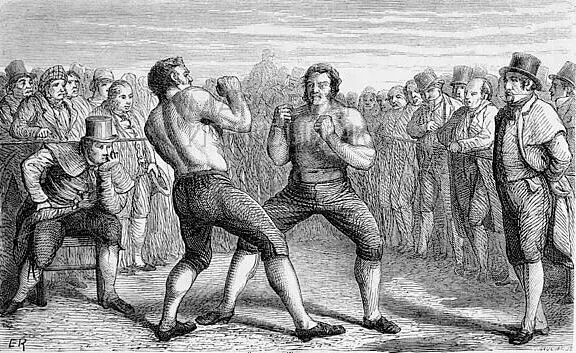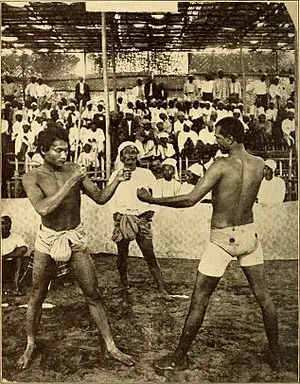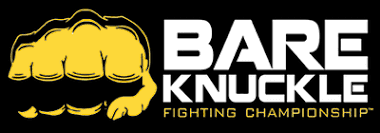Bare-knuckle fighting is a kind of fist fighting, which is done barehanded. As the name refers to, it’s done without gloves or any protective covering.
Bare-knuckle fighting is termed prizefighting, fisticuffs, and classical pugilism. It is known all around the world as the original form of boxing.
What is Bare-knuckle Boxing?
This is a hand to hand combat involves two individuals against each other without any protective padding or gloves. This sport involves striking and grappling.
What is allowed on bare knuckle Boxing?
For striking only use of hands is allowed. Use of legs, elbow, knees, and head-butts for hitting the opponent is strictly forbidden.
Just like western boxing, opponents strike while staying away and dodge the punches.
Fighters hit the arms and upper part of the body and seize the opponent. To defend themselves from grappling turnover, escape and sweep techniques are used.
How a bare knuckle fighter get trained?

A bare-knuckle fighter focuses and works on strength, speed work, footwork, striking on semi-hard surfaces while training and in fights. And of course, he practices hitting with bare hands.
As the use of gloves is forbidden, fighters wrap their hands with gauze tapes or wire tapes.
Bare-knuckle fighting style and the relation with Greek Culture
This sport is very closely related to ancient combat sports, particularly ancient Greek athletic culture. The fight used to hold in large sand pits where any male of any status could challenge openly.
Those fights were used to last till knocking down the opponent and draws in this sport had not existed back then.
This sport was common and popular for entertainment as well as training of soldiers for keeping them in shape for fighting.
Where is Bare-knuckle popular?
Diversifying from place to place, this culture moving from one continent to another, evolutes into different forms, that are, for example, Russian fist fighting, Burmese bare-knuckle fighting, Irish stand down, street fighting, etc.
All these types included in the category of fist fighting have different rules except for one, which is common in all, and that is no striking when the opponent is down.
One of the two wins the rounds as soon as the other gets knocked down. But it is very different from street fighting in terms of rules. Street fighting has no rules at all and includes the use of weapons or any hard object, but neither of these is allowed in bare-knuckle fighting.
History and Evolution of Bare-knuckle:

Ancient combat sports:
In ancient civilizations, full-contact combat sport, such as boxing, wrestling, was popular and commonly practiced in Greece, Rome, and the near east (Pyu Empire, modern-day Burma).
In past, such fights were held in large sandpits, and men used to enter and openly challenge others to fight. The fight lasted till one of the opponents was downed by the other.
England’s Bare-knuckle boxing:
Bare-knuckle fighting was not recognized as a sport in England until the early 16th century. Records of the first formal bout are dated in the year 1681.
A newspaper reported the first-ever news of a bare-knuckle fight in England in 1681.
Its popularity grew so rapidly that by 1698 regular contests were being held in the Royal Theatre of London.
No rule on the firsts England’s bare-knuckle fighting
But those contests were without any kind of rules as well as gloves. It means there was a finite number of rounds, but the fight used to end only until one out of two loses consciousness and gets knocked down.
Also, there were no weight divisions between the fighters. So the lighter ones were easily being dominated and, heavier ones had the advantage over the formers.
It was common and permissible to keep hitting the downed man and fall over him until the mid of 1700s.
These elements made it illegal. Despite these facts, this sport kept gaining popularity in all strata of society. The bare knuckle continued earning popularity and attracting a large number of admirers around the globe.
But any federal or state law didn’t legalize it because of the brutality and the risk of harm and fatality. The main reason was no set of rules for the protection of fighters. Some punching, throwing, choking, and grappling techniques were banned, which evolutes this bare-knuckle sport into modern-day boxing sport.
James Figg the first Bare-knuckle champion of England
James Figg, an English bare-knuckle fighter, was the first Bare-knuckle champion of England. He won the title in 1719 and held this title for eleven years, until his retirement in 1734.
He established an amphitheater in Totten ham court, London. He charges himself as “The Professional in the Noble sciences of Defense”.
Jack Broughton, James Figgs’ pupil took the first steps towards making Bare-knuckle fighting acceptable.
In 1743, brought on devised a set of rules for the first time and worked for this sport’s acceptance as a respectable athletic endeavor.
These rules although not detailed continued to serve their purpose until in 1838, came forward the more detailed London Prize Ring rules.
Some grappling techniques were discarded such as seizing and hitting below the waist. Fighters were encouraged to rely on their fists and were forbidden to hit downed opponents.
Because he served this sport and attracting a large number of pupils to it, Jack Broughton is recognized as “Father of Boxing”.
If you are interested can read : mma history
Burmese bare-knuckle fighting:

The first record of Burmese boxing or Lethwei dates back to Pyu Empire (present-day Myanmar), which existed between the 2nd and mid 11th century.
It was common for the fighters and champions to accept the challenges that were made openly. It was played without any rules, which means no draws and protection of the opponents.
The game lasted till one of the contestants lost consciousness. This game was very popular in this region for entertainment and was used to hold at holidays and festivals. But after Britain’s colonization, this game was banned.
Foundation of Burmese boxing
This sport continued to flourish in villages. Its established practitioner was Kyar Ba Nyein, who came forward and participated in the 1952 Olympics. He established the foundation of modern Burmese boxing and gathered a large number of people around him to keep this sport alive.
Burmese bare-knuckle national sport
Now, Burmese bare-knuckle fighting is a national sport of the country and enjoys considerable popularity in Myanmar and attracts foreign fighters.
Burmese bare-knuckle fighting style:
Burma (Myanmar) has a rich history in martial arts in ancient civilization just its neighboring South East Asian countries.
Burmese bare-knuckle fighting or Lethwei has the reputation of one of the most brutal martial arts in the world.
It involves two individuals against each other that use stand-up striking and clinching techniques.
It is governed by a set of rules. But what makes it different from hand-to-hand combat is the fact that it is a full-contact combat sport.
It means fighters will fight barehanded but they will be allowed to use along with their fists, their elbows, legs, knees, and head-butt.
Head-butt being is referred to as a game-changer. That is why this sport is given the name, The Art of 9 Limbs. It involves and allows the use of 9 body parts as weapons. That earned it the title of the bloodiest martial arts of the Indian Cultural Sphere.
Origin of Burmese bare-knuckle:
Its origin is traced back to Pyu Empire that existed between the 2nd and mid 11th century.
After its origin, it became a popular traditional sport and its matches were held on festivals and holidays. It was played widely to celebrate culture and history.
Modern-day Lethwei:
It was an ancient sport in the region but its popularity grew rapidly and it became a part of the culture. Its beauty and brutality attracted a lot of admirers. When the British colonized that region, present-day Myanmar, they banned this sport due to its brutality.
They declared this sport as barbaric and inhumane. This sport, being banned in cities, was reduced to villages. It was looked down upon as a local sport of villagers until 1952.
Rules of Lethwei:
- Attire: It includes shorts only. Wearing of shoes, shirt, and gloves are prohibited. Contestants are required to wrap tape, gauze, or wire tapes on their hands under the supervision of officials. A gum shield and groin protector is mandatory.
- Permitted techniques: They can use fists, feet, knees, elbows, clinches, and head-butts.
- Rounds: There will be three; four or five rounds each lasting for 3 minutes with the break of 2 minutes between each.
- Traditional rules: Those were notorious for their brutality. According to them, the game will last till one of the opponents is knocked out.For the past 1000 years, all the rules have been the same. The sport is flourishing with all its raw brutality.
- Ring: The fighting ground has shifted from sandpits to rings.
- Score: There is no point system in Lethwei. The only way to win is to knock out the other.
- Draw-system: If both contestants are standing by the end of round 5, it will be declared a draw.
- Time-out: If knockout occurs and the fighter is revived again, he will be able to decide if he wants to continue or not.
- The number of time-outs: Only one time-out is permitted per fight for a player.
Lethwei Style:
- Due to its aggressiveness and straightforward style, it is considered different from other kinds of martial arts and boxing styles of different regions. Another feature that makes it stand out from other martial arts is that it does not include slicker and trickery styles. This style is known for its aggressiveness and simple trick-less style that is slower but powerful. Anciently and traditionally it is believed that fighter must with-stand vigorous thrust of waves like a solid rock rather than slipping and skimming through it like a fish.
- It is similar to the Muay Thai style in many aspects. Both styles include facing the opponent and having a square stance rather than a bladed stance as in karate.
- Its rules favor punches over the kicks, according to which they are scored.
- Its main aim is to knock out the opponent so it hits the target with punches, elbows, and head-butts.
- Clinching is highly preferred. The ability to clinch greatly increases without gloves.
So these all the brutal sports are the cause of the invention of the modern Bare-Knuckle Fighting Championship. Let’s see, BKFC.
Bare-knuckle Fighting Championship:

BKFC is an American-based boxing promotion, which has its headquarters in Philadelphia. The first international state-sanctioned and commissioned bare-knuckle boxing event was held in the United States, in 1889.
Its first event was held in 2018. Notable fighters featured by them are; Jim Alers, Artem Lobov, Ricco Rodriguez, Charles Bennett, Kendall Grove, Chris Lytle, Joe Riggs, Chase Sherman, Leonard Garcia, Eric Prindle, Joey Beltran, Bec Rawlings, Shannon Ritch, Bobby Gunn, Jason Knight, Johnny Bedford, Paulie Malignaggi and Chris Leben.
Origin bare knuckle fighting championship
It was founded in April of 2018 by American professional boxer David Feldman.
Ring setup for Bare-knuckle fighting championship
Each fight takes place in a specialized circular four-rope ring, named the “Squared Circle”… BKFC holds all rounds in a circular four-rope ring.
This ring contains elements of historical Bare-knuckle fighting by containing two scratch lines, 3 feet apart and in the middle of the ring.
These scratch lines are based on the Jack Broughton Rules, which governed Bare-knuckle fighting in the 19th century.
It is a requirement that each fighter must start each round with their front foot on their scratch line.
This is referred to as “Toe the Line”, and it is an instruction given to the fighters at the beginning of each round, followed by “Knuckle Up” which signals the beginning of the round.
Rules in BKFC:
The early bare-knuckle sport was not governed by any rule.
Lack of regulations permitted all kinds of striking, gouging, and grappling techniques.
That included hitting on softer parts, arm locks, choking, punching, throwing, and falling on the foe and keeps hitting even when the other is down.
It was a brutal sport, putting the fighter’s life at stake. It used to result in internal bleeding, breaking of tooth and jaws, breaking of ribs and bones leaving permanent scars and damage to fighters.
These brutal elements made it unacceptable and disqualified from being legalized.
However, to make this sport more respectable and acceptable new rules were formulated for the first time by Jack Broughton in 1743.
New rules for bare-knuckle starting from 1743
He modernized the sport by introducing new and humane rules to reduce the risk of fatalities and harm. He drafted rules which were later on revised and modified into detailed ones.
Many brutal techniques and practices were outlawed such as scratching, tearing, choking, etc.
London Prize Ring Rules devised detailed rules based on Jack Broughton’s rules that governed for over 100 years the world of prizefighting or bare-knuckle fighting.
These rules were later on replaced by the Marques of Queensberry Rules. These rules laid the foundation of modern boxing.
Contestant:
The contestant must have 2 people with him; a second and a bottle-holder. A second must have a sponge with him and the latter must have a bottle.
They are not allowed to intervene in the fight in any way. They cannot insult, show disgust or provoke the fighters in any way or form. They must stay at their assigned corners and leave the player as soon as the round begins.
Permitted techniques: Only use of hands is allowed. Any other body part cannot be used to hit the other. Hitting on the upper body is allowed as well as arms. Hitting below the waist is forbidden. Hard objects cannot be used. Few grappling techniques are allowed.
Rounds: There are 5 rounds. Each lasts for 2 minutes. Knockout time has an 18-second count.
Attire: Tape or gauze on hand. Gloves are prohibited. Wearing of shoes and shirt is not allowed. A fighter can wear just shorts. A gum shield and groin protector is mandatory.
Umpires: Two umpires are chosen by the seconds of both players. Umpire will have the power to decide when the referee or players will appeal to them.
Referee: One referee is chosen by the two umpires. The referee has the power to uphold all decisions. All including, the players as well as umpires, have to abide by the decision without any dispute.
Old rule of bare knuckle martial art
The rules of 1853 (which were somewhat different from the rules of 1838) were as follows:
- That the ring shall be made on turf, and shall be four-and-twenty feet square, formed of eight stakes and ropes, the latter extending in double lines, the uppermost line being four feet from the ground, and the lower two feet from the ground.
- That is the center of the ring a mark be formed, to be termed a scratch; and that at two opposite corners, as may be selected, spaces be enclosed by other marks sufficiently large for the reception of the seconds and bottle-holders, to be entitled “the corners.”
- That each man shall be attended to the ring by a second and a bottle-holder, the former provided with a sponge and the latter with a bottle of water.
- That the combatants, on shaking hands, shall retire until the seconds of each have tossed for choice of position, which adjusted, the winner shall choose his corner according to the state of the wind or sun, and conduct his man thereto, the loser taking the opposite corner.
- That each man shall be provided with a handkerchief of a color suitable to his fancy, and that the seconds proceed to entwine these handkerchiefs at the upper end of one of the center stakes. That these handkerchiefs shall be called “the colors;” and that the winner of the battle at its conclusion shall be entitled to their possession, as the trophy of victory.
- That two umpires shall be chosen by the seconds or backers to watch the progress of the battle, and take exception to any breach of the rules hereafter stated.
- That a referee shall be chosen by the umpires unless otherwise agreed on, to whom all disputes shall be referred; and that the decision of this referee, whatever it may be, shall be final and strictly binding on all parties, whether as to the matter in dispute or the issue of the battle.
- That the umpires shall be provided with a watch, to call time; and that they mutually agree upon which this duty shall devolve, the call of that umpire only to be attended to, and no other person whatever to interfere in calling time.
- That the referee shall withhold all opinion till appealed to by the umpires, and that the umpires strictly abide by his decision without dispute.
- That on the men being stripped, it shall be the duty of the seconds to examine their drawers, and if any objection arises as to the insertion of improper substances therein, they shall appeal to their umpires, who, with the concurrence of the referee, shall direct what alterations shall be made.
- That in future no spikes be used in fighting boots except those authorized by the Pugilistic Benevolent Association, which shall not exceed three-eights of an inch from the sole of the boot, and shall not be less than one-eighth of an inch broad at the point; and, it shall be in the power of the referee to alter, or file in any way he pleases, spikes which shall not accord with the above dimensions, even to filing them away altogether.
- That both men being ready, each man shall be conducted to that side of the scratch next to his corner previously chosen; and the seconds on the one side and the men on the other, having shaken hands, the former shall immediately return to their corners, and there remain within the prescribed marks till the round be finished, on no pretense whatever approaching their principals during the round, under penalty of 5s. For each offense, at the option of the referee. The penalty, which will be strictly enforced, to go to the funds of the Association. The principal to be responsible for every fine inflicted on his second.
- That after the round, when one or both of the men shall be down, the seconds and bottle-holders shall step forward and carry or conduct their fighter to his corner, there affording him the necessary assistance, and no person whatever be permitted to interfere with this duty.
- That at the expiration of thirty seconds (unless otherwise agreed upon) the umpire appointed shall cry “Time,” upon which each man shall rise from the knee of his bottle-holder and walk to his side of the scratch unaided, the seconds and the bottle-holders remaining at their corner; and that either man failing so to be at the scratch within eight seconds, shall be deemed to have lost the battle.
- That on no consideration whatever shall any person be permitted to enter the ring during the battle, nor till it shall have been concluded; and that in the event of such unfair practice, or the ropes and stakes being disturbed or removed, it shall be in the power of the referee to award the victory to that man who in his honest opinion shall have the best of the contest.
- That the seconds and bottle-holders shall not interfere, advise, or direct the adversary of their principal, and shall refrain from all offensive and irritating expressions, in all respects conducting themselves with order and decorum, and confine themselves to the diligent and careful discharge of their duties to their principals.
- That in picking up their men, should the seconds or bottle-holders willfully injure the antagonist of their principal, the latter shall be deemed to have forfeited the battle on the decision of the referee.
- That it shall be “a fair stand-up fight,” and if either man shall willfully throw himself down without receiving a blow, whether blows shall have previously been exchanged or not, he shall be deemed to have lost the battle; but that this rule shall not apply to a man who is a close slip down from the grasp of his opponent to avoid punishment, or from obvious accident or weakness.
- That butting with the head shall be deemed foul, and the party resorting to this practice shall be deemed to have lost the battle.
- That a blow struck when a man is thrown or down, shall be deemed foul. That a man with one knee and one hand on the ground, or with both knees on the ground, shall be deemed down; and a blow given in either of those positions shall be considered foul, providing always, that when in such position, the man so down shall not himself strike or attempt to strike.
- That a blow struck below the waistband shall be deemed foul, and that, in a close, seizing an antagonist below the waist, by the thigh, or otherwise, shall be deemed foul.
- That all attempts to inflict injury by gouging, or tearing the flesh with the fingers or nails, and biting, shall be deemed foul.
- That kicking, or deliberately falling on an antagonist, with the knees or otherwise when down, shall be deemed a foul.
- That all bets shall be paid as the battle-money, after a fight, is awarded.
- That no person, on any pretense whatever, shall be permitted to approach nearer the ring than ten feet, except the umpires and referee, and the persons appointed to take charge of the water or other refreshment for the combatants, who shall take their seats close to the corners selected by the seconds.
- That due notice shall be given by the stakeholder of the day and place where the battle-money is to be given up, and that he be exonerated from all responsibility upon obeying the direction of the referee; and that all parties be strictly bound by these rules; and that in future all articles of agreement for a contest be entered into with strict and willing adherence to the letter and spirit of these rules.
- That in the event of magisterial or other interference, or in case of darkness coming on, the referee shall have the power to name the time and place for the next meeting, if possible, on the same day, or as soon after as may be.
- That should the fight not be decided on the day, all bets, instead of being drawn, shall be put together and divided, unless the fight shall be resumed the same week, between Sunday and Sunday, in which case the bets shall stand and be decided by the event. That where the day named in the articles for a fight to come off is altered to another day in the same week, the bets shall stand. The battle-money shall remain in the hands of the stakeholder until fairly won or lost by a fight unless a draw is mutually agreed upon.
- That any pugilist voluntarily quitting the ring previous to the deliberate judgment of the referee being obtained shall be deemed to have lost the fight.
- That on an objection being made by the seconds or umpire, the men shall retire to their corners, and there remain until the decision of the appointed authorities shall be obtained; that if pronounced “foul,” the battle shall be at an end, but if “fair,” “time” shall be called by the party-appointed, and the man absent from the scratch in eight seconds after shall be deemed to have lost the fight. The decision in all cases to be given promptly and irrevocably, for which purpose the umpires and the referee should be invariably close together.
- That if in a rally at the ropes a man steps outside the ring, to avoid his antagonist or escape punishment, he shall forfeit the battle.
- That the use of hard substances, such as stones, or sticks, or of resin, in the hand during the battle shall be deemed foul and that on the requisition of the seconds, of either man, the accused shall open his hands for the examination of the referee.
- That where a man shall have his antagonist across the ropes in such a position as to be helpless, and to endanger his life by strangulation or apoplexy, it shall be in the power of the referee to direct the seconds to take their man away, and thus conclude the round, and that the man or his seconds refusing to obey the direction of the referee, shall be deemed the loser.
- That all stage fights be as nearly as possible in conformity with the foregoing rules.
My Words about BKFC:
Every fighting sport is all about hitting and not being hit. Opponents hurt each other deliberately with bared knuckles that is what distinguishes it from other kinds of sports.
As per my opinion, Bare-Knuckle fighting competitions should not be held at all. Deadly injuries and fatalities are common in this sport; these consequences of fighting have made this sport controversial.
Fracture in jaws ribs, bones, internal bleeding, dental or eye-blinding injuries, and tearing of flesh or skin can occur.
Powerful hits on the head can cause serious head injuries and permanent brain damage. MRI scans of 80 percent of the boxers show scarring on the brain. It must be outlawed as it is highly controversial and polarized.
